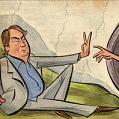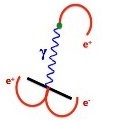Sean Carroll on the arrow of time
In Part 1 of his lecture at the University of Sydney, cosmologist Sean Carroll gives an entertaining and thought-provoking talk about the nature of time, the origin of entropy, and how what happened before the Big Bang might be responsible for the arrow of time we observe today.
Part 2
Sean Carroll on the arrow of time
Moderators: kiore, Blip, The_Metatron
•
8 posts
• Page 1 of 1
Re: Sean Carroll on the arrow of time
One to put some time aside for.
Thanks,
Richard
Thanks,
Richard
- owen375
- Posts: 14
Re: Sean Carroll on the arrow of time
Or... godidit.
Joking aside, this was very interesting and enlightening.
Thanks, Richard.
Joking aside, this was very interesting and enlightening.
Thanks, Richard.
-

InDeoRideo - Posts: 213
- Age: 35


Re: Sean Carroll on the arrow of time
Carroll's an excellent speaker. I have made note of his book because of this talk, thanks for posting!
-

Stephen - Posts: 296
- Age: 42


Re: Sean Carroll on the arrow of time
I'm not really buying the Boltzmann brains hypothesis, though a more quantitative description may be more convincing. For one our brains depend on a long history of smaller stochastic events with a selection bias provided by other stochastic events. The structural complexity can thus exceed any such random fluctuation, even the size of the Big bang, given that the fine grain dynamics within the fluctuation aren't required to have any particular structure itself. The same can't be said for brains. The quantitative question would not so much be what the odds are of a smaller fluctuation relative to larger ones, but what are the odds of observing smaller fluctuations both within the timespan of the existence of a hypothetical Big Bang fluctuation and within a range that can be observed within the observational horizon. Postulating that Boltzmann brains should vastly outnumber Big Bangs says absolutely nothing about the odds of one being observable within the space and time constraints in which the Big Bang exists. Boltzmann brains thought experiment proves nothing without quantifying what we could reasonably expect to observe within our observational space and time constraints.
It also neglects the possibility that a Big Bang type event was preloaded by a long history of smaller fluctuations. This would require some kind of band gap in spacetime to trap certain fluctuations into a stable energy state. Not unlike the way the quantization of QM provides band gaps for atoms to remain stable.

It also neglects the possibility that a Big Bang type event was preloaded by a long history of smaller fluctuations. This would require some kind of band gap in spacetime to trap certain fluctuations into a stable energy state. Not unlike the way the quantization of QM provides band gaps for atoms to remain stable.

-

my_wan - Posts: 967

- Country: US

Interview @ Wired Science: http://ow.ly/1cK1a
I am, somehow, less interested in the weight and convolutions of Einstein’s brain than in the near certainty that people of equal talent have lived and died in cotton fields and sweatshops. - Stephen J. Gould
-

newolder - Name: Albert Ross
- Posts: 7876
- Age: 3

- Country: Feudal Estate number 9
Re: Sean Carroll on the arrow of time
Just had a listen to the entire Carroll talk. Excellent presentation - very clearly put and clear differentiation between what we know and what is speculation. Thanks for posting this one 



A soul in tension that's learning to fly
Condition grounded but determined to try
Can't keep my eyes from the circling skies
Tongue-tied and twisted just an earthbound misfit, I
Condition grounded but determined to try
Can't keep my eyes from the circling skies
Tongue-tied and twisted just an earthbound misfit, I
-

twistor59 - RS Donator
- Posts: 4966


Re: Sean Carroll on the arrow of time
Interesting lecture. Mind you, he like others misses the fact that it's only the Misner/Thorne/Wheeler "geometrical interpretation" of general relativity that predicts a singularity in the middle of a black hole. Einstein never liked the idea, and it isn't present in the Weinberg "field interpretation". The latter is essentially the frozen-star concept, and it makes a huge difference. In this scenario, as you approach the event horizon, time dilation goes infinite. That means the coordinate speed of light as determined by outside observers in the universe at large is zero. That means nothing can happen, similar to the timeless scenario of the heat-death universe. There's a very high energy density, but it's absolutely uniform, so none of the energy is usable. The entropy is very high. It's not too far from the gravastar idea, see http://en.wikipedia.org/wiki/Gravastar and note where it says "This region is called a 'gravitational vacuum', because it is a void in the fabric of space and time."
This is where it gets interesting. If the black hole is a hole in "the fabric of space and time", what happens if you remove the surrounding fabric? You've got a region of very high energy density, and Einstein didn't call it stress-energy for nothing. Stress is akin to pressure. Now it can expand, and the expansion permits motion so "quantum-fluctuation" differences can magnify and stars can form. Local concentrations of energy can drive processes and machines and mathematical physicists. So the entropy has reduced. It then gradually rises again as we move towards heat-death.
This is where it gets interesting. If the black hole is a hole in "the fabric of space and time", what happens if you remove the surrounding fabric? You've got a region of very high energy density, and Einstein didn't call it stress-energy for nothing. Stress is akin to pressure. Now it can expand, and the expansion permits motion so "quantum-fluctuation" differences can magnify and stars can form. Local concentrations of energy can drive processes and machines and mathematical physicists. So the entropy has reduced. It then gradually rises again as we move towards heat-death.
- Farsight
- Posts: 20
8 posts
• Page 1 of 1
Who is online
Users viewing this topic: No registered users and 1 guest


